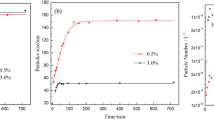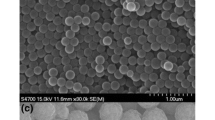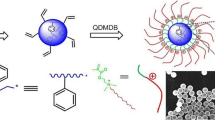A comprehensive research has been carried out to develop a method for obtaining particle size standards based on aqueous suspensions of polystyrene latex spheres. For the synthesis of suspensions, a method of seeded emulsion polymerization of styrene under excess amount of dispersion medium is proposed. The equipment from the State Primary Standard of Units of Dispersed Parameters of Aerosols, Suspensions and Powder Materials (GET 163-2020) was used in the work. The particle size distribution of the suspension samples synthesized during the study was analyzed by the methods of dynamic light scattering and laser diffraction. The metrological characteristics of synthesized suspensions have been studied. It was established that depending on the methods of emulsion polymerization and micro-emulsification of styrene, monodisperse microspheres of polystyrene latex of various diameters can be obtained. The effect of the amount of introduced surfactant on the process of quasi-spontaneous micro-emulsification of the monomer during seeded polymerization was studied. Based on the study results, aqueous suspensions of monodisperse polystyrene latex spheres with a median particle diameter of 0.31 and 0.54 μm were proposed as particle size standards. The study results can be used to obtain monodisperse particles larger than 1 μm by seeded polymerization.



Similar content being viewed by others
Notes
GOST R 8.774-2011. Disperse composition of liquid media. Determination of particle size by dynamic light scattering.
References
D. I. Belenkii, D. V. Averkin, D. V. Vishnevetskii, et al., Meas. Tech., 64, 4, 328–332 (2021), https://doi.org/https://doi.org/10.1007/s11018-021-01936-y.
I. A. Gritskova, S. V. Zhachenkov, N. I. Prokopov, and P. E. Ilmenev, Emulsion Polymerization of Hydrophobic Monomers in Highly Dispersed Emulsions, Vysokomolek. Soedin., (A) 33, No. 7, 1476–1483 (1991)
N. I. Prokopov and I. A. Gritskova, Russ. Chem. Rev., 70, No. 9, 890–900 (2001), https://doi.org/https://doi.org/10.1070/RC2001v070n09ABEH000669.
A. Tuncel and E. Piskin, Art. Cells, Blood Subs. and Immob. Biotech., 19, No. 1, 229–253 (1991), https://doi.org/10.3109/10731199109117830.
W. M. Brouwer, J. Appl. Polym. Sci., 38, 1335–1346 (1989), https://doi.org/https://doi.org/10.1002/app.1989.070380712.
J. Ugelstad, M. S. El-Aasser, and J. W. Vanderhoff , Polym. Lett. Ed., 11, 503–513 (1973), https://doi.org/https://doi.org/10.1002/pol.1973.130110803.
R. Paulen, B. Benyahia, M. A. Latifi, and M. Fikar, Comput. Aided Chem. Eng., 32, 721–726 (2013), https://doi.org/https://doi.org/10.1016/B978-0-444-63234-0.50121-4.
A.J. Macbeth, Zh. Lin, and J.M. Goddard, MethodsX, 7, 101110 (2020), https://doi.org/10.1016/j.mex.2020.101110.
T. Wang, S. Shi, F. Yang, L. M. Zhou, and S. Kuroda, J. Mater. Sci., 45, 3392–3395 (2010), https://doi.org/https://doi.org/10.1007/s10853-010-4449-9.
X. Fan, X. Jia, H. Zhang, B. Zhang, C. Li, and Q. Zhang, Langmuir, 29, 11730–11741 (2013), https://doi.org/https://doi.org/10.1021/la402759w.
E. D. Sudol, M. S. El-Aasser, and J. W. Vanderhoff , J. Polym. Sci. A: Polym. Chem., 24, 3499–3513 (1986), https://doi.org/https://doi.org/10.1002/pola.1986.080241231.
J. W. Vanderhoff , J. F. Vitkuske, E. B. Bradford, and T. Alfrey, Jr., J. Polym. Sci., 20, 225–234 (1956), https://doi.org/https://doi.org/10.1002/pol.1956.120209501.
B. Thomson, A. Rudin, and G. Lajoie, J. Polym. Sci. A: Polym. Chem., 33, 345–357 (1995), https://doi.org/https://doi.org/10.1002/pola.1995.080330301.
T. Uyar, A. El-Shafei, X. Wang, J. Hacaloglu, and A. Tonelli, J. Incl. Phenom. Macrocycl. Chem., 55, 109–121 (2006), https://doi.org/https://doi.org/10.1007/s10847-005-9026-5.
Author information
Authors and Affiliations
Corresponding author
Additional information
Translated from Metrologiya, No. 12, pp. 64–68, December, 2022.
Rights and permissions
Springer Nature or its licensor (e.g. a society or other partner) holds exclusive rights to this article under a publishing agreement with the author(s) or other rightsholder(s); author self-archiving of the accepted manuscript version of this article is solely governed by the terms of such publishing agreement and applicable law.
About this article
Cite this article
Averkin, D.V. Synthesis of Particle Size Standards Based on Aqueous Suspensions of Polystyrene Latex Spheres. Meas Tech 65, 936–941 (2023). https://doi.org/10.1007/s11018-023-02173-1
Received:
Accepted:
Published:
Issue Date:
DOI: https://doi.org/10.1007/s11018-023-02173-1




